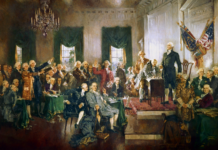Americans have some tough choices ahead of them. They can either accept the responsibility of self-governance or continue to be propagandized by a false two-party system that seems intent on driving the nation into eternal damnation. The common perception driving most people’s beliefs is that there is a left and right-wing party representing conservative and liberal values. Locked in an ideological battle for the hearts and minds of America, we are treated daily to a never-ending display of heated debates over social issues that Americans are told they should care about. The Republicans, allegedly standing for liberty and individual responsibility, valiantly call out the Democrats for their obvious, socialist leanings. The Democrats continually use race and equality issues to bash Republicans in the head, while portraying them as uncompassionate and greedy. People on both sides, every four years, place all their hopes in the one candidate that can win the election and set the nation on the right course, once and for all. While the people continue to argue over non-sensical issues that have no real consequence or can’t easily be changed from one administration to the next, the nation goes deeper into debt, our dollar becomes more worthless, and our government continues to grow while sucking the life out of the taxpayer. The latest example is the most recent omnibus bill to keep the government funded under the threat of a shutdown. This is something that happens every four years, no matter who is president. It is almost as if they are deliberately working to fool the people into believing there is a conflict between the two parties, while they deceptively advance an agenda to spend us into oblivion. Cloward and Piven anyone?
It isn’t that people don’t understand they are being propagandized; they do. Especially on the right. Patriotic Americans know the mainstream media is ripe with left-leaning bias and an agenda to portray America as the evil of the world. Truthfully, the left believes the same thing. They have been conditioned to view the world in terms of communism or fascism. The right, to them, represents extremism while holding left-wing views exemplifies compassion and deep-rooted concern for humanity. This was a brilliant ploy executed by the communists. They claimed everything they did was in the name of pursuing a fair and equal society while comparing themselves to Adolf Hitler, who had no other motive than the complete elimination of what he referred to as inferior races. The term “right-wing fascism” was successfully attached to the Nazi regime, making it easy to equate any opposition to “compassionate socialism” as hateful bigotry. The problem is that the propagandists have successfully trapped people in their ideological boxes. People do not realize how their prospective outlook is itself, propaganda, meant to shift their attitudes in one way or another. They have not yet understood that everything they do, every belief they hold, is under the microscope and extensively studied for the sole purpose of gaining compliance with an agenda that would otherwise, be rejected.
Joost Meerloo stated in his book The Rape of the Mind that “communication specialists and public-opinion engineers, have concluded through decades of study that propaganda can be successful in creating any perception, while also providing the illusion that people are freely choosing their own opinions” (p.67). The decades of study he refers to are the studies into human behavior and their reactions to mass media communications. He also states that “at this very moment, elaborate research into motivation is going on, whose aim is to find out why and what the buyer likes to buy. What makes him tick” (p. 67)? The study of mass psychology has taken on a life of its own, and what is known about the group dynamic has shaped the researchers’ beliefs pertaining to the manipulation of public opinion. The group, according to the book Propaganda, “has mental characteristics distinct from those of the individual and is motivated by impulses and emotions, which cannot be explained on the basis of what we know of individual psychology” (p. 47). When it comes to politics, this is easily explainable, as the beliefs and emotions of both political parties are largely shaped by the media outlets they expose themselves to. This can’t be applied to everyone on the individual level; however, it is safe to say that the conservative right follows the Fox News narrative and the left, almost any other network, as long as it isn’t Fox. The perception of both sides is that their preferred networks are trustworthy of reporting daily events without any bias. The reality of the situation is that the media exists to guide and mold public thought based on the decades of research Meerloo referred to.
According to the book Media Effects: Advances in Theory and Research, one of the primary aims of mass media is to “is to overcome the psychological barriers which prevent the change of attitudes and opinions” (p. 157). What does this mean in terms of the larger agenda? If American conservatives admit there is an attempt to move the country to the left, wouldn’t this quote pertain directly to them? The socialist Democrats, for example, do not need to convince their base of anything. Republicans, particularly Christians, are the biggest obstacle to the socialist agenda, meaning it is their psychological barriers to socialism that need to be overcome, theoretically. They do this by developing an acute understanding of the beliefs and attitudes which already dominate the mass, public mind. Bernays puts it like this – the propagandist studies the issues and understands the public attitudes towards them. He understands which part of a message gains their attention and what is needed to be done to guide opinion towards a desired outcome. This is based on constant and direct observation of human behavior, their existing beliefs, and their reactions to the stimuli fed to them through the media (p. 48).
It is not sufficient to understand only the mechanical structure of society, the groupings and cleavages, and loyalties. An engineer may know all about the cylinders and pistons of a locomotive, but unless he knows how steam behaves under pressure, he cannot make his engine run. Human desires are the steam that makes the social machine work. Only by understanding them can the propagandist control that vast, loose-jointed mechanism that is modern society. (Bernays, 1928, p. 52)
Americans must come to understand that there is a concerted effort to present the news they watch in a manner that aligns with the beliefs and attitudes of the targeted audience. The intent is to shift opinions towards an outcome they may not otherwise desire. This is called framing. According to the book Dynamics of Persuasion: Communications and Attitudes in 21st Century, a frame is a way to present stories from the point of a “perceived reality and make them more salient in a communicating text in such a way as to promote a particular problem definition, causal interpretation, moral evaluations, and/or treatment options” (p. 349). Research has found that framing issues through certain points of view can be very successful in producing compliance, and or attitude change (p. 349). This is because people are not as deep of thinkers as they believe they are. Cass Sunstein states in his book Nudge, (p. 37) that people lack the ability to see if their reaction to a particular message would change if it was framed in a different way. One reason, he states, is because they wouldn’t know what to make of the contradictions that would arise.
Even the most intelligent among us fall for the way messages are framed because they are usually done so within the moral frameworks of our existing beliefs and biases. This is called Moral Foundations Theory. This is a method of study used to determine if people’s attitudes can be shifted based on the moral principles embedded within a media story. Ironically, as the government study, Shifting Liberal and Conservative Attitudes Using Moral Foundation Theory points out, conservatives are more likely to shift their opinions to the left, than liberals to the right, if the story is framed the right way. This is done using what they refer to as “The Purity to Worldview” morality that researchers assigned to the right. If they successfully present issues within the framework of liberty, or freedom for all groups, they can shift the opinions of those on the right, more towards a left-leaning worldview. This is what is meant by the words “social change” that we all hear so often.
This is why it is so important for Americans to QUESTION EVERYTHING they see and hear coming from the media. They are applying everything they have learned through decades of research into what motivates human beings; what makes them change their opinions, what makes them comply, what makes them simply accept what is going on without any resistance? Like the book Political Persuasion and Attitude Change states (p. 1) “political persuasion is about the number of people when push comes to shove, that can be brought from one side to the other.” Everything you see is an attempt to pull you to the left, even the things that seem to fit firmly within the parameters of your belief system. While Americans are bickering over issues that seem to be of great importance, there is an agenda driving on that is destroying our nation. Most Americans understand the concept of a divide and conquer agenda. This is easy to see. What is more difficult to see is the subtle manner in which decades of study have been used to, as Edward Hunter states in Brainwashing in Red China, “pull the wool over our own eyes and actually have fun doing it” (p. 211).
If you enjoy this content please check out my latest book.
Without a Shot Indeed: Inducing Compliance to Tyranny Through Conditioning and Persuasion.

























